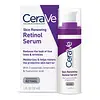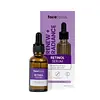What's inside
What's inside
 Key Ingredients
Key Ingredients

 Benefits
Benefits

 Concerns
Concerns

 Ingredients Side-by-side
Ingredients Side-by-side

Water
Skin ConditioningGlycerin
HumectantCaprylic/Capric Triglyceride
MaskingPotassium Cetyl Phosphate
EmulsifyingHydrogenated Palm Glycerides
EmollientPolysorbate 20
EmulsifyingPEG-40 Stearate
EmulsifyingCyclopentasiloxane
EmollientHydroxyethylcellulose
Emulsion StabilisingPotassium Phosphate
BufferingCeramide NP
Skin ConditioningCeramide AP
Skin ConditioningCeramide EOP
Skin ConditioningCarbomer
Emulsion StabilisingNiacinamide
SmoothingIsoceteth-10
EmulsifyingDimethicone/Vinyl Dimethicone Crosspolymer
Skin ConditioningTriethanolamine
BufferingCetearyl Alcohol
EmollientBehentrimonium Methosulfate
Cichorium Intybus Root Extract
MaskingLecithin
EmollientRetinol
Skin ConditioningSilica
AbrasiveSodium Lauroyl Lactylate
EmulsifyingCholesterol
EmollientPhenoxyethanol
PreservativeTocopherol
AntioxidantAlcohol
AntimicrobialHydroxyacetophenone
AntioxidantCitric Acid
BufferingHydrolyzed Hyaluronic Acid
HumectantPentylene Glycol
Skin ConditioningXanthan Gum
EmulsifyingPhytosphingosine
Skin ConditioningButyrospermum Parkii Butter
Skin ConditioningEthylhexylglycerin
Skin ConditioningWater, Glycerin, Caprylic/Capric Triglyceride, Potassium Cetyl Phosphate, Hydrogenated Palm Glycerides, Polysorbate 20, PEG-40 Stearate, Cyclopentasiloxane, Hydroxyethylcellulose, Potassium Phosphate, Ceramide NP, Ceramide AP, Ceramide EOP, Carbomer, Niacinamide, Isoceteth-10, Dimethicone/Vinyl Dimethicone Crosspolymer, Triethanolamine, Cetearyl Alcohol, Behentrimonium Methosulfate, Cichorium Intybus Root Extract, Lecithin, Retinol, Silica, Sodium Lauroyl Lactylate, Cholesterol, Phenoxyethanol, Tocopherol, Alcohol, Hydroxyacetophenone, Citric Acid, Hydrolyzed Hyaluronic Acid, Pentylene Glycol, Xanthan Gum, Phytosphingosine, Butyrospermum Parkii Butter, Ethylhexylglycerin
Water
Skin ConditioningButylene Glycol
HumectantGlycerin
HumectantBetaine
HumectantSorbeth-30
EmulsifyingRetinyl Palmitate
Skin Conditioning3-O-Ethyl Ascorbic Acid
Skin ConditioningPrunus Amygdalus Dulcis Seed Extract
Skin Conditioning1,2-Hexanediol
Skin ConditioningHydroxyacetophenone
AntioxidantAllantoin
Skin ConditioningPEG-40 Hydrogenated Castor Oil
EmulsifyingCarbomer
Emulsion StabilisingAminomethyl Propanol
BufferingPanthenol
Skin ConditioningXanthan Gum
EmulsifyingDisodium EDTA
Sodium Hyaluronate
HumectantCyclohexane
SolventCaprylic/Capric Triglyceride
MaskingPolyglyceryl-10 Myristate
Skin ConditioningPEG-15 Glyceryl Stearate
EmulsifyingOctyldodecanol
EmollientTocopheryl Acetate
AntioxidantPentylene Glycol
Skin ConditioningLecithin
EmollientIsononyl Isononanoate
EmollientParfum
MaskingHydrolyzed Rice Protein
Skin ConditioningHydrogenated Lecithin
EmulsifyingBHT
AntioxidantPhenoxyethanol
PreservativeTetrasodium EDTA
Benzyl Benzoate
AntimicrobialWater, Butylene Glycol, Glycerin, Betaine, Sorbeth-30, Retinyl Palmitate, 3-O-Ethyl Ascorbic Acid, Prunus Amygdalus Dulcis Seed Extract, 1,2-Hexanediol, Hydroxyacetophenone, Allantoin, PEG-40 Hydrogenated Castor Oil, Carbomer, Aminomethyl Propanol, Panthenol, Xanthan Gum, Disodium EDTA, Sodium Hyaluronate, Cyclohexane, Caprylic/Capric Triglyceride, Polyglyceryl-10 Myristate, PEG-15 Glyceryl Stearate, Octyldodecanol, Tocopheryl Acetate, Pentylene Glycol, Lecithin, Isononyl Isononanoate, Parfum, Hydrolyzed Rice Protein, Hydrogenated Lecithin, BHT, Phenoxyethanol, Tetrasodium EDTA, Benzyl Benzoate
 Reviews
Reviews

Ingredients Explained
These ingredients are found in both products.
Ingredients higher up in an ingredient list are typically present in a larger amount.
This ingredient is an emollient, solvent, and texture enhancer. It is considered a skin-softener by helping the skin prevent moisture loss.
It helps thicken a product's formula and makes it easier to spread by dissolving clumping compounds.
Caprylic Triglyceride is made by combining glycerin with coconut oil, forming a clear liquid.
While there is an assumption Caprylic Triglyceride can clog pores due to it being derived from coconut oil, there is no research supporting this.
Learn more about Caprylic/Capric TriglycerideCarbomer is a polymer of acrylic acid. Its main role is to create a gel consistency.
A high amount of carbomer can cause pilling or balling up of products. Don't worry, most products contain 1% or less of carbomer.
Glycerin is already naturally found in your skin. It helps moisturize and protect your skin.
A study from 2016 found glycerin to be more effective as a humectant than AHAs and hyaluronic acid.
As a humectant, it helps the skin stay hydrated by pulling moisture to your skin. The low molecular weight of glycerin allows it to pull moisture into the deeper layers of your skin.
Hydrated skin improves your skin barrier; Your skin barrier helps protect against irritants and bacteria.
Glycerin has also been found to have antimicrobial and antiviral properties. Due to these properties, glycerin is often used in wound and burn treatments.
In cosmetics, glycerin is usually derived from plants such as soybean or palm. However, it can also be sourced from animals, such as tallow or animal fat.
This ingredient is organic, colorless, odorless, and non-toxic.
Glycerin is the name for this ingredient in American English. British English uses Glycerol/Glycerine.
Learn more about GlycerinHydroxyacetophenone is antioxidant with skin conditioning and soothing properties. It also boosts the efficiency of preservatives.
This ingredient is not irritating or sensitizing.
Lecithin is a term for a group of substances found in the cell membranes of plants, animals, and humans. They are made up of mixture of phospholipids.
This ingredient has emollient and emulsifying properties.
As an emollient, lecithen helps soften the skin and creates a barrier to keep moisture in.
As an emulsifier, it also helps prevent water and oil ingredients from separating. Lecithin can also help ingredients be better absorbed by the skin.
This is because the phospholipids in lecithin produce liposomes. Liposomes help other ingredients get through the skin barrier.
Depending on the source of this ingredient, lecithin may not be fungal acne safe. This is because some sources of lecithin come from soybean oil, which may feed the malassezia yeast that feeds fungal acne.
We recommend reaching out to the brand you are purchasing from to inquire about the source of their lecithin.
Some other names for this ingredient include soy lecithin and deoiled soy lecithin.
Learn more about LecithinPentylene glycol is typically used within a product to thicken it. It also adds a smooth, soft, and moisturizing feel to the product. It is naturally found in plants such as sugar beets.
The hydrophilic trait of Pentylene Glycol makes it a humectant. As a humectant, Pentylene Glycol helps draw moisture from the air to your skin. This can help keep your skin hydrated.
This property also makes Pentylene Glycol a great texture enhancer. It can also help thicken or stabilize a product.
Pentylene Glycol also acts as a mild preservative and helps to keep a product microbe-free.
Some people may experience mild eye and skin irritation from Pentylene Glycol. We always recommend speaking with a professional about using this ingredient in your routine.
Pentylene Glycol has a low molecular weight and is part of the 1,2-glycol family.
Learn more about Pentylene GlycolPhenoxyethanol is a preservative that has germicide, antimicrobial, and aromatic properties. Studies show that phenoxyethanol can prevent microbial growth. By itself, it has a scent that is similar to that of a rose.
It's often used in formulations along with Caprylyl Glycol to preserve the shelf life of products.
Water. It's the most common cosmetic ingredient of all. You'll usually see it at the top of ingredient lists, meaning that it makes up the largest part of the product.
So why is it so popular? Water most often acts as a solvent - this means that it helps dissolve other ingredients into the formulation.
You'll also recognize water as that liquid we all need to stay alive. If you see this, drink a glass of water. Stay hydrated!
Learn more about WaterXanthan gum is used as a stabilizer and thickener within cosmetic products. It helps give products a sticky, thick feeling - preventing them from being too runny.
On the technical side of things, xanthan gum is a polysaccharide - a combination consisting of multiple sugar molecules bonded together.
Xanthan gum is a pretty common and great ingredient. It is a natural, non-toxic, non-irritating ingredient that is also commonly used in food products.
Learn more about Xanthan Gum